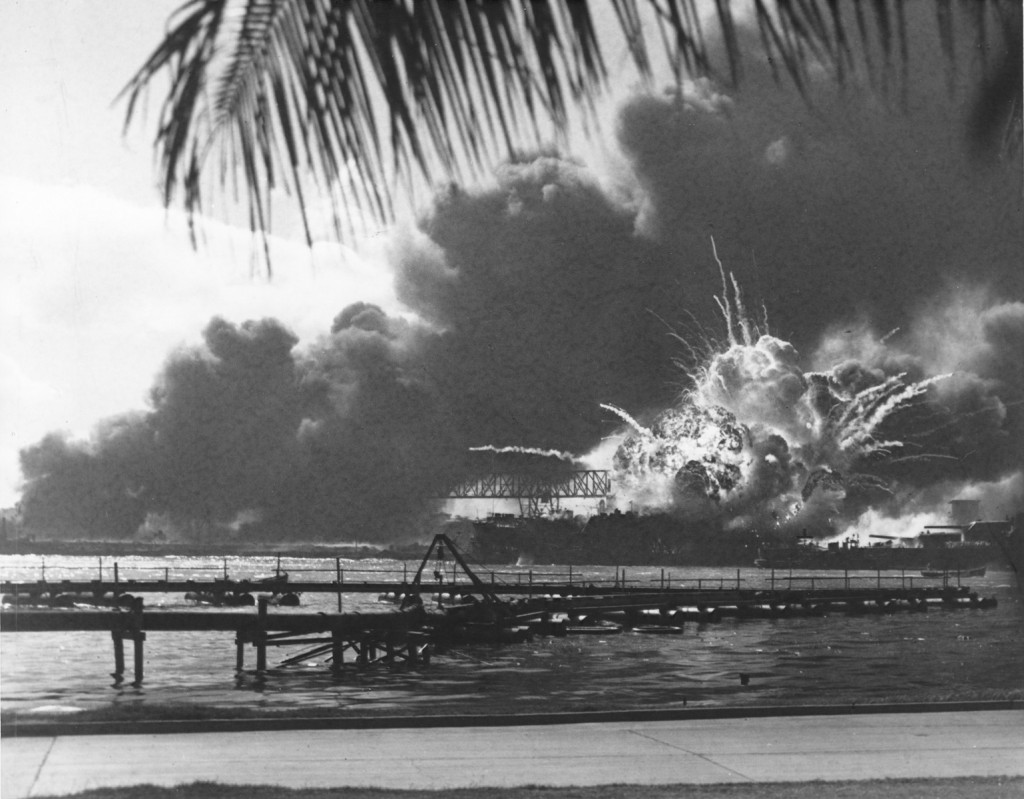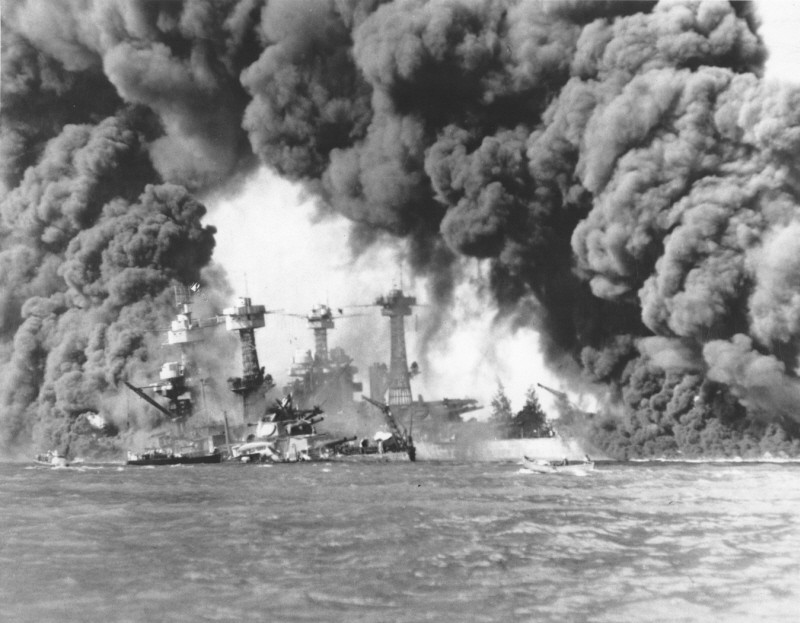
Pearl Harbor
On December 7, 1941, the Imperial Japanese Navy conducted a surprise air and sea assault on the US Naval Station Pearl Harbor, located on the Hawaiian island of Oahu. At this time, the US Pacific Fleet was docked at Pearl Harbor. The attack shocked Americans and drew the United States into World War II.
Key Facts
-
1
The United States suffered heavy casualties at Pearl Harbor. President Franklin D. Roosevelt said that the day would live in “infamy” due to the shocking and devastating nature of the attack.
-
2
The day after the attack, the United States declared war on Japan. A few days later, Germany declared war on the United States. The Allied powers (led by Great Britain, the Soviet Union, and the United States) fought the Axis powers (led by Germany, Italy, and Japan) until 1945.
-
3
Japan’s assault on Pearl Harbor was a major turning point in World War II. After the attack, the vast majority of Americans supported the United States entering the war.
On December 7, 1941, the Imperial Japanese Navy launched a surprise attack on the US Pacific Fleet stationed at Pearl Harbor. The damage was devastating. Eight of the nine American battleships at the harbor were either sunk or damaged. More than 150 American aircraft were destroyed. On a single day, more than 2,300 American service people were killed and nearly 1,200 Americans were wounded.
The assault on Pearl Harbor marked a major turning point in World War II (1939–1945). It drew the United States into a global conflict that would continue until 1945 and leave millions dead.
“Yesterday, December 7, 1941—a date which will live in infamy—the United States of America was suddenly and deliberately attacked by naval and air forces of the Empire of Japan.”
—From President Franklin D. Roosevelt’s speech to Congress, December 8, 1941
Japanese Expansion and US Policy in the Pacific: The 1930s
During the 1930s, Imperial Japan sought to expand its empire on the Pacific Rim. Japan took over the Manchuria region of China in 1931. Sporadic fighting between Japan and China occurred for the next six years. A full-fledged war (known as the Second Sino-Japanese War) began in July 1937, when Japan invaded China and captured the capital city, Nanjing.
At the same time, Japan expanded its military forces and began to align with Nazi Germany and Fascist Italy. In November 1936, Germany and Japan signed the Anti-Comintern Pact, creating an alliance against the Soviet Union. Then, in September 1940, Germany, Italy, and Japan signed the Tripartite Pact. This pact formalized the alliance between the three countries known as the Axis powers.
Japan’s expansion into China was widely condemned in the United States and elsewhere. President Franklin D. Roosevelt feared that Japan would advance into Hong Kong, southeast Asia, and the Philippines (a US territory at the time). In 1940, the US government offered to provide China with aircraft and monetary loans. Over the next year, tensions between the United States and Japan increased. Roosevelt’s government passed economic sanctions against Japan and expanded the Lend-Lease program to provide military aid to China.
The Attack on Pearl Harbor

As US policies and sanctions against Japan became more aggressive, Japan grew determined to attack the United States. Japanese military leaders called for a surprise attack that aimed to destroy the entire US Pacific Fleet at Pearl Harbor. If it could cripple US naval power in the Pacific, the Japanese military assumed that the United States would be unable to interfere with Japan’s territorial conquests.
On November 26, 1941, a large naval strike force with six aircraft carriers bearing more than 400 planes set sail from Japan. This force operated under strict radio silence and avoided shipping lanes to escape detection. Japan’s vessels journeyed some 3,500 miles to a point about 230 miles north of Oahu, from where the attack on Pearl Harbor would be launched.
At 7:55 a.m. (Hawaii time) on Sunday, December 7, the first of two waves of Japanese naval aircraft attacked Pearl Harbor. US forces were caught by surprise. The devastating events at Pearl Harbor marked the first time the United States had been attacked by a foreign power on its own soil since the War of 1812, nearly 130 years earlier.
Although the assault on Pearl Harbor became the most notorious event to occur on December 7, 1941, it was not the only target attacked that day. Japanese forces struck multiple US territories in the Pacific, including the Philippines, Guam, Midway Island, and Wake Island. They also attacked the British territories of Malaya, Singapore, and Hong Kong. Within a week, Japan controlled all of these territories.
The US Enters World War II
One of the most significant consequences of the attack on Pearl Harbor was that it pulled the United States into World War II. Before the attack, the majority of Americans had been reluctant to see the United States enter the war. After Pearl Harbor, that changed.
On December 8, 1941, the day after the attack, the US Congress declared war on Japan. President Roosevelt signed the declaration of war a few hours later. In an address to the American people, the president said, “We are now in this war. We are all in it—all the way. Every single man, woman, and child is a partner in the most tremendous undertaking of our American history.”
On December 11, Germany’s Chancellor Adolf Hitler declared war on the United States. He cited provisions in the 1940 Tripartite Pact. The pact specified that Germany, Japan, and Italy would “assist one another with all political, economic and military means when one of the three contracting powers is attacked by a power at present not involved in the European war or in the Chinese-Japanese conflict.”
In his declaration of war against the United States, Hitler expressed Germany’s “deep appreciation” to the Japanese government for attacking Pearl Harbor. He also drew on long-standing antisemitic conspiracy theories and falsely claimed that President Roosevelt was controlled by Jews. In addition, Hitler said that war had been “forced” upon Germany by the United States and Great Britain. His statement disregarded the fact that Germany and Japan were the aggressors in war.
Within days of the attack, World War II was reshaped. The United States joined the Allied powers in war against the Axis alliance. During the course of World War II, more than 250,000 Americans were wounded on the Pacific front. More than 100,000 US service members died while fighting there.
Timeline of the Attack on Pearl Harbor
December 6, 1941
Japan launches five Type A submarines, hoping to infiltrate Pearl Harbor and torpedo American ships. The US Navy attacks and sinks two of the submarines and captures a third.
December 7, 1941
7:55 a.m., Hawaii (1:25 p.m. in Washington, DC)—A coordinated Japanese naval and aerial attack begins at Pearl Harbor. The attack last 75 minutes. Approximately 2,400 American military personnel and civilians are killed.
1:47 p.m., Washington, DC—Secretary of the Navy Frank Knox alerts President Franklin D. Roosevelt to the ongoing attacks.
2:25 p.m., Washington, DC—President Roosevelt’s Press Secretary Stephen Early issues a press release announcing, “The Japanese have attacked Pearl Harbor from the air and all naval and military activities on the island of Oahu.”
3:05 p.m., Washington, DC—President Roosevelt meets with military and diplomatic advisors. He also speaks by phone with British Prime Minister Winston Churchill.
8:40 p.m., Washington, DC—President Roosevelt briefs his Cabinet on the attack. Around 9:30 p.m., Congressional leaders join them.
December 8, 1941
12:30 p.m., Washington, DC—President Roosevelt addresses a joint session of Congress. He delivers a short speech that begins: “Yesterday, December 7, 1941, a date that will live in infamy…”
1:24 p.m., Washington DC—With one dissenting vote, Congress approves a declaration of war against Japan.
4:10 p.m., Washington, DC—President Roosevelt signs the declaration of war. The United States officially enters World War II.
December 11, 1941
3:00 p.m., Berlin, Germany and Rome, Italy (8:00 a.m. in Washington, DC)—Hitler delivers a speech to the Reichstag (German parliament). He expresses support for Imperial Japan and declares war on the United States. At the same time, Italian dictator Benito Mussolini gives a public speech declaring war on the United States.
12:30 p.m., Washington, DC—President Roosevelt asks Congress to recognize that war now exists with Germany and Italy.
3:00 p.m., Washington, DC—With only one dissenting vote, Congress recognizes war with Germany and Italy. President Roosevelt signs the declarations of war that afternoon.
Footnotes
-
Footnote reference1.
In December 1941, Hawaii time was 5 ½ hours earlier than Eastern Time.
Critical Thinking Questions
Investigate the context of war and mass murder in Europe at the time the United States entered the war.
Did the course of the war in the Pacific affect the possibility of rescue of the endangered Jews by the Allies and other nations?
What was the relationship between the progress of the war and the mass murder of Europe’s Jews?

